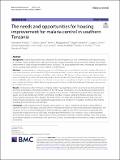| dc.description.abstract | Background Malaria disproportionately afects low-income households in rural communities where poor housing
is common. Despite evidence that well-constructed and mosquito-proofed houses can reduce malaria risk, housing
improvement is rarely included in malaria control toolboxes. This study assessed the need, magnitude, and opportuni ties for housing improvement to control malaria in rural Tanzania.
Methods A mixed-methods study was conducted in 19 villages across four district councils in southern Tanzania. A
structured survey was administered to 1292 community members to assess need, perceptions, and opportunities for
housing improvement for malaria control. Direct observations of 802 houses and surrounding environments were
done to identify the actual needs and opportunities, and to validate the survey fndings. A market survey was done to
assess availability and cost of resources and services necessary for mosquito-proofng homes. Focus group discussions
were conducted with key stakeholders to explore insights on the potential and challenges of housing improvement
as a malaria intervention.
Results Compared to other methods for malaria control, housing improvement was among the best understood
and most preferred by community members. Of the 735 survey respondents who needed housing improvements,
a majority needed window screening (91.1%), repairs of holes in walls (79.4%), door covers (41.6%), closing of eave
spaces (31.2%) and better roofs (19.0%). Community members invested signifcant eforts to improve their own
homes against malaria and other dangers, but these eforts were often slow and delayed due to high costs and
limited household incomes. Study participants suggested several mechanisms of support to improve their homes,
including government loans and subsidies.
Conclusion Addressing the need for housing improvement is a critical component of malaria control eforts in
southern Tanzania. In this study, a majority of the community members surveyed needed modest modifcations and
had plans to work on those modifcations. Without additional support, their eforts were however generally slow;
households would take years to sufciently mosquito-proof their houses. It is, therefore, crucial to bring together
the key players across sectors to reduce barriers in malaria-proofng housing in endemic settings. These may include
government subsidies or partnerships with businesses to make housing improvement more accessible and afordable
to residents. | en_US |

